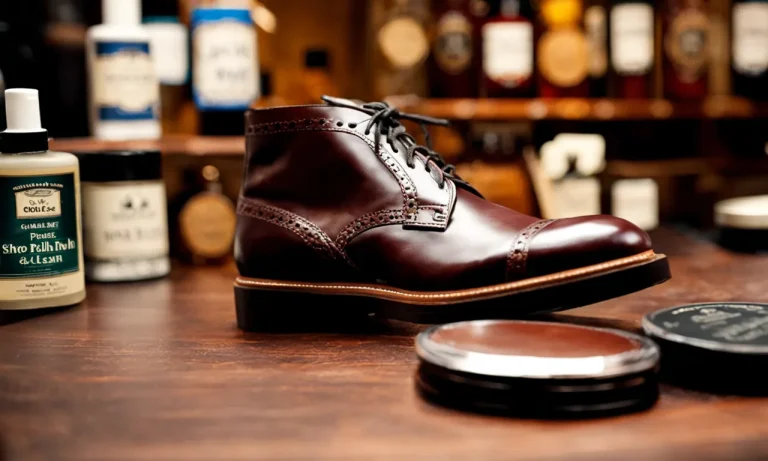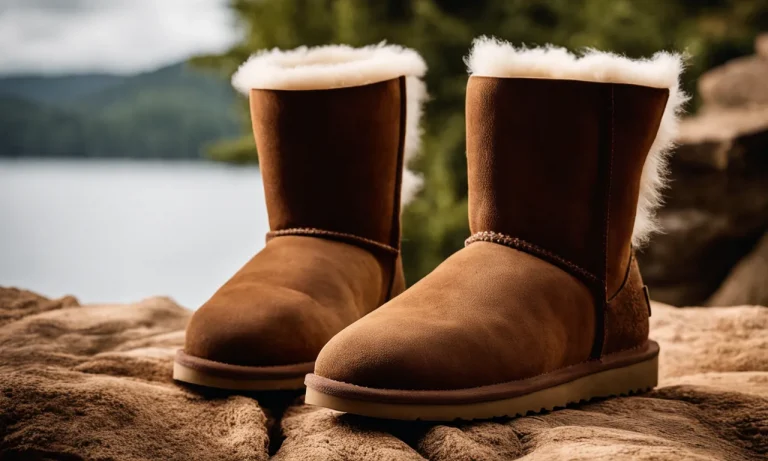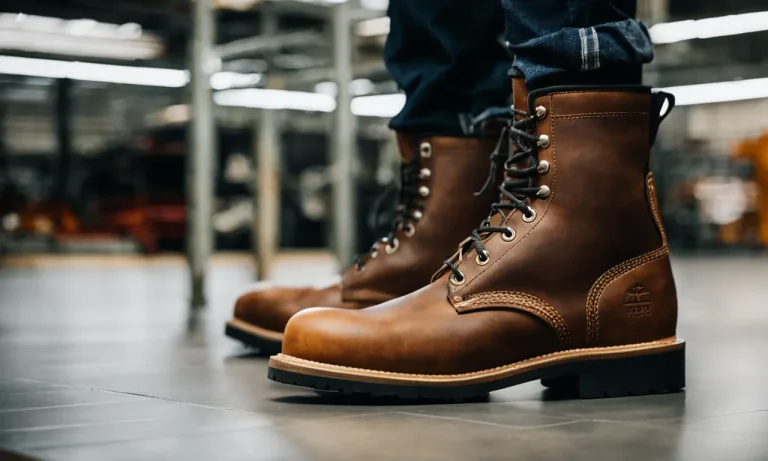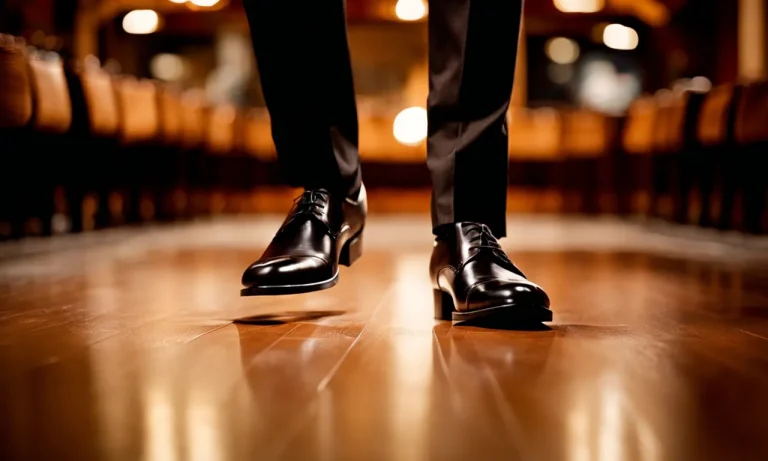Shoes are an indispensable part of our daily lives. We rely on quality footwear to keep our feet comfortable and protected. But have you ever wondered who makes these critical products? If you want to know what a professional who designs, repairs, and creates shoes is called, you’ve come to the right place.
In short, a shoe maker is typically called a cobbler. However, there are some other names and specializations in shoemaking crafts that are worth learning about.
The Main Names for a Shoe Maker
Cobbler
A cobbler is one of the most commonly used terms for a shoe maker. The word “cobbler” originates from the Old French word “cobler,” which means “to mend.” Cobblers are skilled craftsmen who specialize in repairing and refurbishing footwear.
They are experts at fixing worn-out soles, replacing heels, and even stitching up torn leather. Cobblers often work in small shops or as independent artisans, catering to customers who want to extend the life of their beloved shoes.
They possess a deep understanding of different shoe construction techniques and use a variety of tools to complete their work.
Shoemaker
The term “shoemaker” is another commonly used name for a professional who makes and repairs shoes. Shoemakers have been around for centuries, and their craft has evolved alongside advancements in technology and materials.
They are highly skilled in the art of shoemaking, utilizing their expertise to create footwear that is not only stylish but also comfortable and durable. Shoemakers often work in factories or workshops, using specialized machinery and tools to cut, shape, and assemble various components of a shoe.
They may work with a team of designers and technicians to bring their designs to life.
Cordwainer
A cordwainer is a term that is less commonly used today but still holds historical significance in the world of shoemaking. The word “cordwainer” comes from the Old French word “cordewan,” which refers to a type of fine leather.
In the past, cordwainers were highly regarded craftsmen who exclusively worked with high-quality leather to create bespoke shoes for their clients. They had a reputation for producing footwear of exceptional quality and craftsmanship.
While the term “cordwainer” is not as widely recognized as “cobbler” or “shoemaker” today, it is still used to describe skilled artisans who uphold the tradition of working with fine leather and creating custom-made shoes.
For more information on the history of shoemaking and the different roles within the industry, you can visit https://www.shoemakingcoursesonline.com/history-of-shoemaking/. This website provides a comprehensive overview of the evolution of shoemaking and the various professions associated with it.
The History and Evolution of Shoemaking
Shoemaking, an age-old craft, has a rich history that dates back thousands of years. The evolution of shoemaking has been influenced by various factors such as cultural traditions, technological advancements, and societal changes.
Let’s delve into the fascinating journey of how shoes have been crafted throughout history.
Origins of Ancient Footwear
The origins of shoemaking can be traced back to ancient civilizations such as Egypt, Mesopotamia, and China. In these early cultures, shoes were primarily made from natural materials like leather, bark, and woven fibers.
Ancient Egyptians, for example, crafted sandals from papyrus leaves, while the Chinese employed silk and straw to create their footwear. These early shoes were often simple in design and served the purpose of protecting the feet from rough terrain.
Rise of Shoe Guilds and Workshops
During the Middle Ages, the art of shoemaking began to flourish with the establishment of shoe guilds and workshops. These guilds were associations of skilled shoemakers who set standards for craftsmanship and regulated the trade.
They played a significant role in preserving and advancing the craft of shoemaking. The guilds ensured that shoemakers were properly trained and adhered to quality standards, which led to the development of various specialized techniques and styles.
Shoe workshops during this time were often small-scale operations, with shoemakers working individually or in small teams. They meticulously handcrafted shoes, paying attention to every detail, and often customized them to fit the unique measurements of their clients.
These bespoke shoes were considered a symbol of status and wealth.
Industrialization and Mass Production
The industrial revolution in the 18th and 19th centuries brought about significant changes in the shoemaking industry. The invention of machines, such as the sewing machine and the lasting machine, revolutionized the production process.
These machines allowed for faster and more efficient production, enabling shoemakers to meet the growing demand for footwear in rapidly urbanizing societies.
Mass production techniques, pioneered by manufacturers like the famous American shoemaker, Thomas B. Adams, further transformed the industry. The introduction of assembly line production and standardized sizing allowed for the production of shoes on a larger scale, making them more affordable and accessible to a wider population.
Today, shoemaking continues to evolve with advancements in technology and materials. From traditional craftsmanship to cutting-edge manufacturing processes, the art of shoemaking has come a long way. Whether it’s handmade luxury shoes or mass-produced sneakers, the history and evolution of shoemaking have shaped the footwear we wear today.
The Shoemaking Process
The process of shoemaking involves several steps that require skill, precision, and attention to detail. Each stage plays a crucial role in creating a well-crafted shoe that is both comfortable and stylish.
Here, we will take a closer look at the three main stages of the shoemaking process: design and pattern making, cutting and assembly, and lasting and finishing.
Design and Pattern Making
The design and pattern making stage is where the creative process begins. A shoe designer or shoemaker will often start by sketching their ideas on paper or using computer-aided design (CAD) software. This allows them to visualize the final product and make adjustments as needed.
Once the design is finalized, a pattern is created. The pattern serves as a blueprint for cutting the various pieces of leather or fabric that will make up the shoe.
During this stage, the shoemaker takes into account factors such as the desired style, fit, and functionality of the shoe. They consider the type of footwear being made, whether it’s a casual sneaker or a formal dress shoe.
They also take measurements and consider the ergonomics of the foot to ensure a comfortable fit.
Cutting and Assembly
Once the pattern is complete, the next step is cutting and assembly. The shoemaker carefully cuts the leather or fabric using specialized tools and techniques. This requires precision to ensure that each piece is cut to the correct size and shape.
The pieces are then assembled using various methods, such as stitching or gluing, depending on the type of shoe being made.
The cutting and assembly stage is where the craftsmanship of the shoemaker truly shines. Attention to detail is crucial as they work to align seams, create smooth edges, and ensure a secure construction.
The materials used may vary depending on the desired quality and style of the shoe, with options ranging from genuine leather to synthetic materials.
Lasting and Finishing
The lasting and finishing stage is where the shoe really takes shape. In this stage, the shoe is fitted onto a last, which is a mold shaped like a foot. The shoemaker carefully stretches and shapes the leather or fabric over the last, ensuring a proper fit and form. This process is known as lasting.
After lasting, the shoe goes through a series of finishing touches. This includes trimming excess material, applying any necessary reinforcements or support structures, and adding decorative elements such as buckles or laces.
The shoe is then polished or treated to enhance its appearance and durability.
Types of Shoemakers
Bespoke Shoemakers
Bespoke shoemakers are artisans who create customized and made-to-measure shoes for individuals. They pride themselves on their attention to detail and craftsmanship, ensuring that each pair of shoes is unique and tailored to the customer’s specifications.
These shoemakers often work closely with their clients, taking measurements and discussing design preferences to create a truly personalized experience. The process of making bespoke shoes involves multiple stages, including pattern making, leather selection, cutting, stitching, and finishing.
The end result is a pair of shoes that fit perfectly and reflect the customer’s style and personality.
Orthopedic Shoemakers
Orthopedic shoemakers specialize in designing and crafting footwear that provides support and alleviates foot-related problems. They work closely with orthopedic doctors and podiatrists to create shoes that accommodate specific foot conditions, such as flat feet, high arches, or pronation issues.
Orthopedic shoemakers use their knowledge of biomechanics and anatomy to create shoes with custom arch supports, cushioning, and other features that promote proper foot alignment and comfort. These specialized shoes can help individuals with foot conditions lead a more comfortable and pain-free life.
Repair-Focused Cobblers
Repair-focused cobblers are skilled craftsmen who specialize in repairing and restoring shoes. They possess a wide range of skills, including patching up worn-out soles, replacing heels, and fixing broken stitching. These cobblers can also stretch or shrink shoes to improve comfort and fit.
Their expertise extends beyond just repairing shoes; they can also restore leather, remove stains, and polish shoes to make them look brand new. Repair-focused cobblers play a vital role in extending the lifespan of shoes and reducing waste, making them an environmentally friendly choice for footwear maintenance.
Modern Shoe Production Methods
Gone are the days when shoemaking was purely a manual craft. Today, shoe production has evolved and embraced modern methods that incorporate technology and innovative materials. These advancements have not only increased production efficiency but also allowed for greater customization and design possibilities.
Let’s take a closer look at some of the modern shoe production methods:
Computer-Aided Design
Computer-Aided Design (CAD) has revolutionized the way shoes are designed and developed. Shoe designers now utilize specialized software to create detailed 3D models of their designs. This technology allows for precise measurements and intricate detailing, ensuring a perfect fit and aesthetic appeal.
CAD also enables designers to experiment with various styles, colors, and materials, giving rise to a diverse range of shoe designs.
One of the significant advantages of CAD in shoe production is the ability to generate virtual prototypes. This eliminates the need for physical samples, saving time and reducing costs. Designers can make adjustments and modifications in real-time, speeding up the development process.
Additionally, CAD software enables designers to share their designs with manufacturers worldwide, facilitating global collaboration and innovation.
Advanced Machinery
Modern shoe factories are equipped with advanced machinery that automates various stages of production. These machines excel in precision and efficiency, enabling faster and more consistent manufacturing processes.
From cutting and shaping materials to stitching and assembling components, these machines streamline production and improve overall quality control.
For instance, automated cutting machines utilize computer-controlled blades to cut out shoe patterns from various materials, ensuring accuracy and minimizing waste. Similarly, automated stitching machines can stitch uppers and soles together with precision, creating strong and durable bonds.
These machines not only increase production speed but also reduce human errors, resulting in higher-quality shoes.
Synthetic Materials
In addition to traditional leather, modern shoe production has embraced the use of synthetic materials. Synthetic materials offer several advantages, such as durability, flexibility, and water resistance.
They also provide designers with an extensive range of colors and textures to choose from, enabling more creative designs.
One popular synthetic material used in shoe production is polyurethane (PU). PU offers excellent cushioning properties, making it ideal for athletic shoes. It is also lightweight and breathable, enhancing comfort during long hours of wear.
Additionally, PU can be molded into various shapes and designs, allowing for greater customization.
Another synthetic material gaining popularity is recycled polyester. By repurposing plastic bottles and other waste materials, shoe manufacturers contribute to sustainable practices. Recycled polyester offers similar properties to traditional polyester, such as durability and moisture-wicking capabilities, making it an eco-friendly choice for environmentally conscious consumers.
Conclusion
Shoemakers have a rich history and play an invaluable role in providing quality footwear for our daily lives. While the main terms for these skilled craftspeople are cobblers and cordwainers, the field has evolved to include many specializations and modern technologies.
Understanding the shoemaking process helps underscore the amount of care and labor that goes into a good pair of shoes. So next time you lace up your favorite kicks, take a moment to appreciate the talented cobbler who helped bring them to life!






